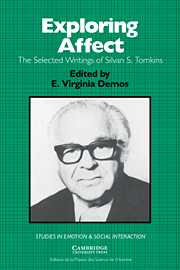Book contents
- Frontmatter
- Contents
- Foreword
- Editor's preface
- List of contributors
- Chronology
- Introduction
- Part I Affect theory
- Introduction
- Selections by Silvan S. Tomkins
- Part II Affect and ideology
- Introduction
- Selections by Silvan S. Tomkins
- Part III The face of affect
- Introduction
- Selections by Silvan S. Tomkins
- Part IV Script theory: The differential magnification of affect
- Introduction
- Selections by Silvan S. Tomkins
- The rise, fall, and resurrection of the study of personality
- Script theory
- Revisions in script theory – 1990
- The varieties of shame and its magnification
- Part V Human being theory: A foundation for the study of personality
- Introduction
- Selections by Silvan S. Tomkins
- A complete annotated bibliography of Silvan S. Tomkins's writings
- References
- Author index
- Subject index
- Titles in the series
The rise, fall, and resurrection of the study of personality
Published online by Cambridge University Press: 10 November 2010
- Frontmatter
- Contents
- Foreword
- Editor's preface
- List of contributors
- Chronology
- Introduction
- Part I Affect theory
- Introduction
- Selections by Silvan S. Tomkins
- Part II Affect and ideology
- Introduction
- Selections by Silvan S. Tomkins
- Part III The face of affect
- Introduction
- Selections by Silvan S. Tomkins
- Part IV Script theory: The differential magnification of affect
- Introduction
- Selections by Silvan S. Tomkins
- The rise, fall, and resurrection of the study of personality
- Script theory
- Revisions in script theory – 1990
- The varieties of shame and its magnification
- Part V Human being theory: A foundation for the study of personality
- Introduction
- Selections by Silvan S. Tomkins
- A complete annotated bibliography of Silvan S. Tomkins's writings
- References
- Author index
- Subject index
- Titles in the series
Summary
Any science may have a brief period of accelerated growth whenever it is blessed with the generation of a theory, the invention of a new method, or the discovery of a new phenomenon. But it flourishes most when there is that rarity, a conjunction of these three essential ingredients: first, the generation of a theory of sufficient economy, scope, and power to engage the energies of a generation of investigators; second, the invention of a set of methods sufficiently precise to enable the test of such theory; and third, examination of data of scope and depth sufficient to validate the theory, to enable continuing discovery, and at the same time to critically illuminate the original theory and thereby raise new problems radical enough to both require and suggest a theory of greater power and generality.
Darwin did this for biology, and Freud did it for the study of personality. Under the leadership of Henry A. Murray, a generation of American personologists explored, illuminated, and enriched Freud's psychoanalytic theory of personality. From the Harvard Psychological Clinic, for a period of thirty years, there issued seminal innovations in theory, methodology, and empirical investigation which deepened and extended the golden age of personality study initiated by Freud. At the theoretical level, Murray provided a highly differentiated set of variables for the description of personality. These included, in addition to motivational “needs” and “press,” variables for the interpretation of abilities, as well as those complex social and political structures he called “sentiments.”
- Type
- Chapter
- Information
- Exploring AffectThe Selected Writings of Silvan S Tomkins, pp. 303 - 311Publisher: Cambridge University PressPrint publication year: 1995



